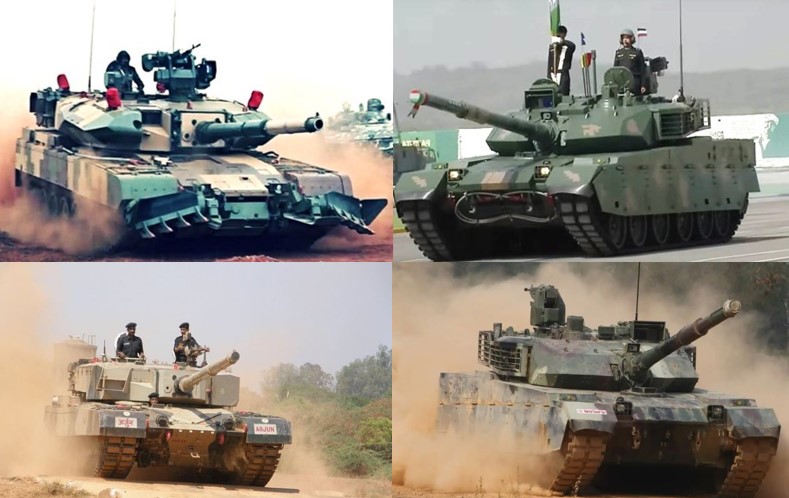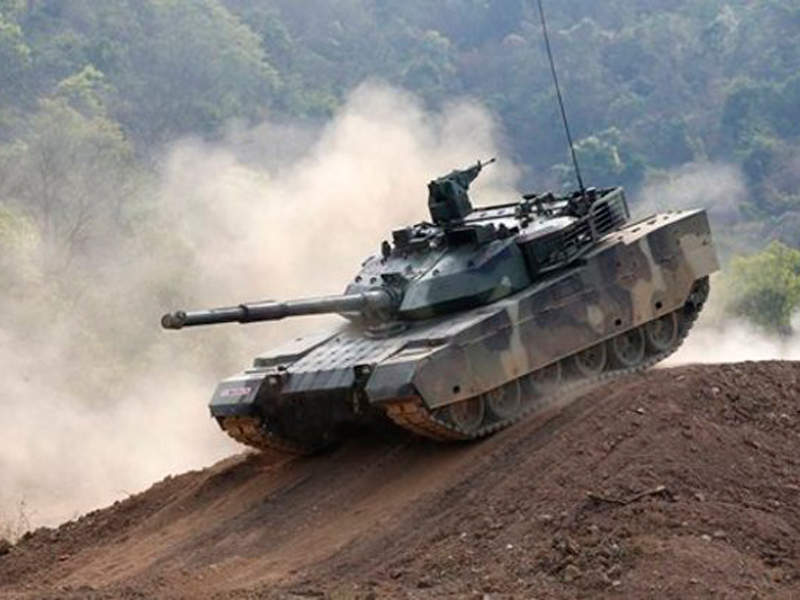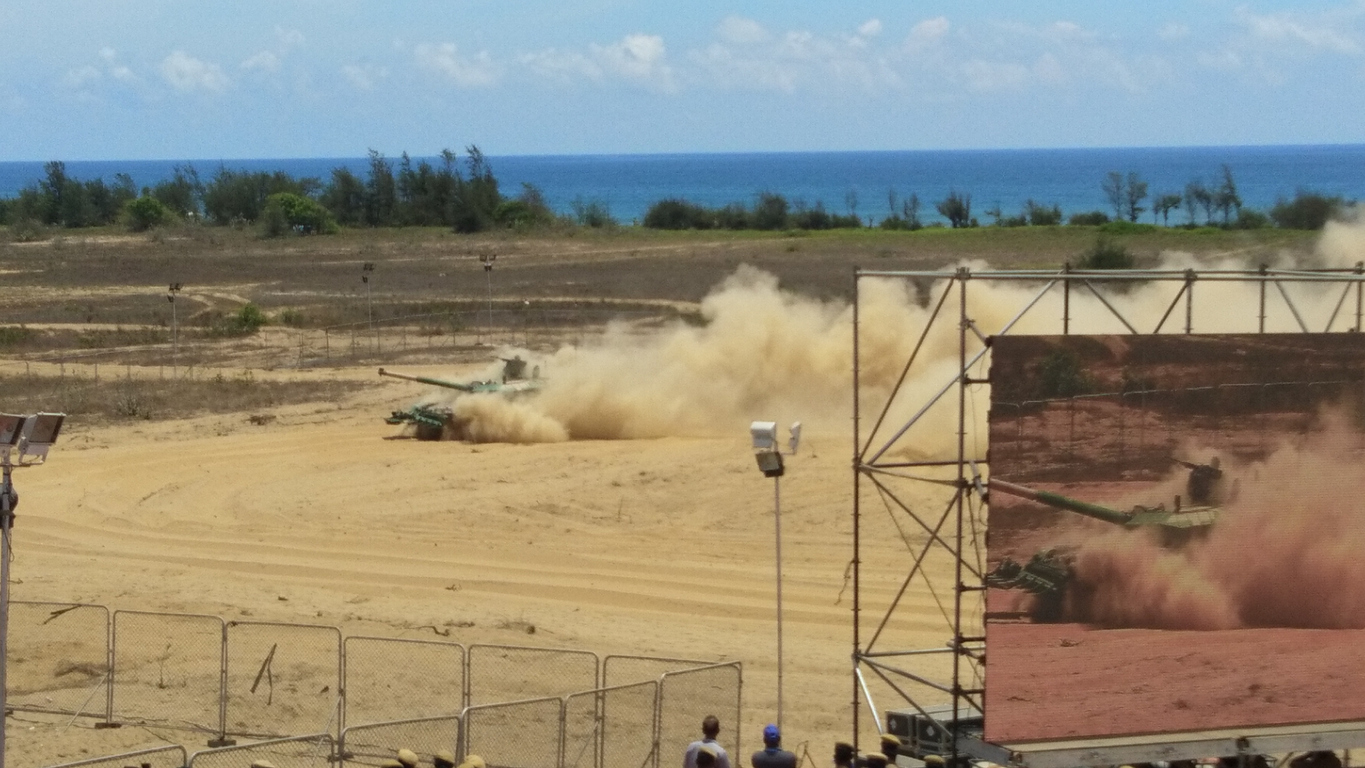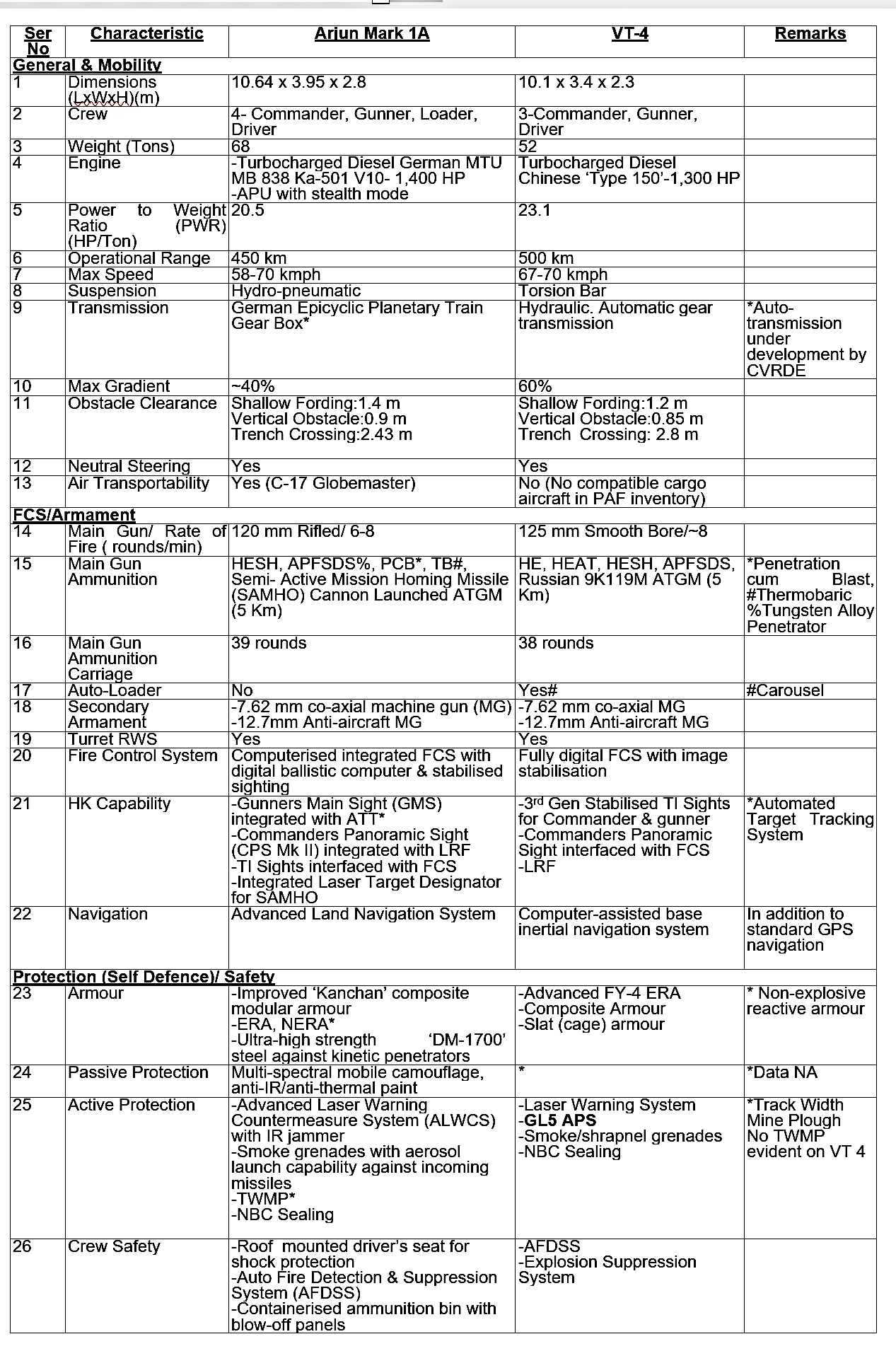
India’s Arjun Mark-1A Vs Pakistan’s VT-4: Rival Chariots of Fire

No manoeuvre machine on land can cause the adversary as much anxiety and fear of being annihilated as can the Main Battle Tank- indeed there is no sound more terrifying than the rumble of steel over battle grounds- the terror of these deadly chariots of fire.
-By the Author
The development of the battle tank progressed from World War I through different weight classifications (light, medium and heavy) and through role-specific models-those designed for anti-infantry roles and ‘cruiser tanks’ with higher mobility and fire power designed specifically for anti-tank and cavalry roles. However, the requirement of combining roles into a ‘universal tank’ to increase survivability, enhance potency and reduce logistics burden continued to loom large. This led to the development of the ‘main battle tank’ (MBT), with improved tank & gun design, armour capability against varied anti-armour threats and advancements in transmission and power-pack technology, allowing these vehicles to perform multiple roles including anti-armour, spearheading breakthrough operations, reconnaissance, destruction of enemy defences and infantry support.
What is a MBT?
While there are numerous attempts to holistically define a MBT, some open source definitions that encapsulate the essence are reproduced below:-
‘A MBT is a tank that fills the armour-protected direct fire and manoeuvre roles of modern armies’.
‘A tank with a good balance of firepower, cross-country mobility and armoured protection, and therefore capable of carrying out the roles of breakthrough, exploitation and infantry support’.
Why is There a Need to Compare the Arjun Mark-1A & the VT4?
As a key battle asset, both India and Pakistan have paid due attention to keeping their AFV fleets abreast with each other, if not always against a global median. The Indo-Pakistan conflicts of 1965/1971 underlined the indispensable role of the armoured corps in general and the MBT in particular in ‘ensuring’ favourable battle outcomes. Thus was born the proverbial ‘cat and mouse’ game between both countries of attempting to achieve the upper edge in MBT capability.
In the absence of full-fledged indigenous capability, which would ensure greater adaptability whilst operating in harsh terrain/weather conditions of the subcontinent, both countries turned to world markets to upscale respective armour profiles. The Pakistan Army (PA) initially toyed with the idea of acquiring the US M1 Abrams, prompting India to look to occidental markets for a counter. Unfortunately, sanctions post Pokhran severely restricted availability of global technology, but catalysed the realisation that long term indigenous solutions were the only way forward. India thus settled for expertise instead- infusing German know-how of the Leopard-2 MBT into its indigenous MBT program. Alongside, the lack of complete transfer of technology from the Russians hampered the serviceability of the T-Series of Russian MBTs in service with India, wherein even the frontline T-90 MBT had to sport indigenous content. The Arjun MBT Program, first launched in 1986, provided hope to fill this chasm of self-reliance in production of a world-class MBT. Arjun Mark-1A, a milestone on the road to development of the Future MBT (FMBT) by India, is expected to bolster India’s self-reliant armour might for the times to come.

VT 4 negotiating a slope
Pakistan similarly embarked on a program to upgrade its MBT profile from the vintage US tanks used in the 1965 and 1971 conflicts to the present Ukrainian T-80 UD and VT-1/ Al-Khalid, jointly developed by China and Pakistan. However, a reeling economy and lethargic R&D have led Pakistan to give up the notion of indigenous MBT production, leading to acquisition of the Chinese VT-4, which will be the PA’s ‘spearhead’ MBT.
If the stated present and perspective MBT roadmaps of India and Pakistan hold true, then the future is likely to be dominated by indigenous production/ foreign acquisitions by India/ Pakistan respectively. It is in this context that comparison of the latest development/ acquisition of both countries in the form of India’s Arjun Mark-1A and Pakistan’s China-acquired VT-4 respectively merit comparison.
Present Development/ Acquisition Profile
The Arjun MBT is a ‘third-generation’ MBT with 120 mm rifled gun developed by DRDO’s Combat Vehicles Research & Development Establishment (CVRDE), which commenced designing in 1986 and completed the same in 1996, when 14 Pre-Production Series (PPS 1-14) tanks were delivered to the Indian Army (IA) for user trials. These trials highlighted about 10 shortcomings, which were subsequently rectified in PPS-15. Based on performance of PPS-15, the CCS, based on recommendations of the IA, cleared limited series production and 124 tanks were contracted for the IA. Serial production of the MBT began in 2003 at Heavy Vehicles Factory, Avadi and the MBT entered service with the IA in 2004. Two Armoured Regiments were equipped with the Arjun MBT and participated in comparative trials against the Russian T-90 MBT. It is reported that the Arjun Mark-1 outperformed the T-90 in most areas! Delivery of all 124 Arjun MBT with ‘Kanchan’ composite armour, indigenous Fire Control System (FCS), digital ballistic firing computer, a turret remote weapon station (RWS) and laser warning receiver based ‘active protection system’ was completed in 2012. The Arjun Mark-1A is an improved variant of the previous version incorporating improved firepower, mobility and stability. The Mark-1A variant has close to 89 modifications/improvements, with higher indigenous content (41%) as compared to the previous version (37%). Major upgrades as requested by the IA have been made in armament, FCS, protection and transmission systems, which have also accorded it simultaneous target tracking/ computing and consequent ‘hunter-killer’ (HK) capability. Shri Narendra Modi, Hon’ble PM, formally handed over the Arjun Mark-1A to Chief of Army Staff at Chennai in February this year. In September 2021, an order for 118 tanks was placed, at a contract cost of approximately US $1.014 Billion, with a final cost per piece of US $ 8.6 Million. The realisation of this contract will see wider employability of the Arjun Mark-1A in the IA’s Order of Battle.

Arjun Mark 1A on the move
The VT-4 MBT (Prototype version MBT-3000) is a ‘third-generation’ improved variant of the VT-1/ Al Khalid/ Type 90 II (Prototype version MBT-2000) designed specifically for export, with a 125 mm smooth bore gun and an indigenous powertrain. It is manufactured by Inner Mongolia First Machinery Group Corporation, a subsidiary of China North Industries Group Corporation (NORINCO). It is similar in design to the Soviet T-72. Development of the VT-4 commenced in 2009. The MBT was first displayed at Eurosatory Weapons Fair in France in 2012. The VT-4 boasts of the world-class GL-5 Active Protection System (APS), composite armour and FY-4 Explosive Reactive Armour (ERA), a carousel type auto-loader, RWS and HK capabilities. It is reported that 176 out of the initially decided number of 300 VT-4 MBTs have been presently contracted for the PA as its third importer after Nigeria and Thailand. The VT-4 was demonstrated by the PA at Jhelum Firing Ranges on 22 September this year, thus confirming its induction into the PA, at a reported final cost of US $ 4.9 Million per piece. The MBT has been inducted into a strike formation at Gujranwala last month, as PA’s most advanced armour platform.
Comparison
Comparison of both MBTs would necessarily involve evaluation of capabilities in terms of mobility, FCS/armament and protection/ safety. A comparative table of specifications is given below.

- Mobility. The Arjun Mark-1A has marginally larger dimensions and is 30% heavier than the VT-4. The weight is a significant factor in deciding mobility in varied terrain configurations, especially impacting mobility across bridges in water obstacle ridden terrain. The heavier weight of the Arjun will also adversely impact overland and air transportation options. However, while the Arjun can be transported in the C-17 Globemaster available with India, Pakistan does not have any integral airlift capability for the VT-4. The more powerful engine on the Arjun reduces its PWR disadvantage vis-a-vis the VT-4, which still ends up with a superior PWR. Operation of the Arjun over soft ground is made easier due to ground pressure exerted (0.84 Kg/cm2) which is lower than that of the T-72 (0.89 Kg/cm2) on which the VT-4 is based. The operational ranges and speeds are comparable. However, present lack of auto- transmission in the Arjun is bound to affect manoeuverability and fuel efficiency. The hydro-pneumatic suspension of the Arjun would provide greater stability for fire-on-the-move manoeuvres and reduce crew fatigue. The Arjun’s Auxiliary Power Unit (APU) is equipped with a ‘stealth mode’ which reduces IR signature while powering the FCS and other subsystems in ‘engine-off’ mode.
- FCS/ Armament. The 120mm gun fitted on the Arjun is the standard calibre used in most NATO Nations. The rifled barrel facilitates firing of HESH rounds as the imparted spin, in addition to providing greater stability in flight, allows for more uniform distribution of the plasticised explosive on the target. While the smooth bore gun of the VT-4 is more suitable to firing HEAT ammunition and cannon launched ATGMs, successful trials of the SAMHO ATGM from the Arjun would seem to obviate this disadvantage. The PCB and TB ammunition developed for the Arjun would lend greater diversity and lethality in its armament against material and personnel targets. The absence of the auto-loader in the Arjun would seem to affect rate of fire, though the Arjun looks to offset the same with an extra crew member (loader). Also manual loading facilitates use of containerised ammunition bins, adding to crew safety. Both tanks have HK capability and associated fitments, while the FCS seem comparable, prima facie. The indigenously developed ALNS of the Arjun offers reliable land navigation in featureless terrain e.g. deserts. The VT-4 is also likely to have similar navigation capability.
- Protection/ Safety. The Arjun mounts greater overall armour protection than the VT-4. The NERA is relatively less expensive, passive and easy to integrate- it sandwiches a composite non-metallic structure between metallic plates to deflect shaped-charge warheads. While the Arjun has a functional close-in APS, the GL-5 of the VT-4 scores a definite edge in affording greater protection against incoming missiles, which it detects at a range of 100m with 360º capability and fires two rockets guided by four multi-mission fire control radars. The Arjun TWMP (visibly absent in the VT-4) will accord anti-tank mine protection. Other than comparable safety features, the containerised ammunition of the Arjun offers significantly greater internal crew safety against spontaneous/ externally stimulated ammunition ‘cook-off’ .
Future MBT (FMBT)
In keeping with the quest for MBT modernisation, the FMBT or Next Generation MBT (NGMBT) is being developed by DRDO to replace the IA’s T-72 fleet. The FMBT will feature significant improvements over the Arjun MBT including lighter overall weight (approximately 50 tons) and enhanced mobility, improved ‘Bharat Power-Pack’(~1500-1800 HP), auto-transmission, advanced electro-optical sight systems, Network-Centric-Warfare capabilities and a modular design to facilitate further upgrades. The FMBT is also expected to mount a high-power Directed Energy Weapon, earlier explained @ Chanakya Forum https://chanakyaforum.com/directed-energy-weapons1/ . The FMBT is likely to be fielded by the end of the present decade.
Conclusion
A balanced analysis of features would indicate that the Arjun Mark-1A enjoys a definite competitive edge over the VT-4 in terms of armour protection and lethality in terms of variety of ammunition. Greater attention also seems to have been paid to crew comfort and safety in the Arjun Mark-1A. While the FCS of both MBTs seem comparable, the hydro-pneumatic suspension of the Arjun Mark-1A lends to greater firing accuracy during fire & manoeuvre operations. Though the Arjun Mark-1A mounts a more powerful engine, the PWR of the tank is hampered by its greater overall weight. This aspect is likely to adversely affect ground mobility as explained in the article, though the IA will have an edge due to availability of strategic lift capability to shift the asset between/ within theatres. The development of the FMBT and future upgrades to the present program should obviate these disadvantages. The Arjun Mark-1A Program, along with the present incorporation of about 200 Micro, Small and Medium Industries, Private Firms and DPSUs, stands firm in commitment to operational self-reliance and the vision of ‘Atmanirbhar Bharat’.
Disclaimer
The opinions expressed in this article are the author’s own and do not reflect the views of Chanakya Forum. All information provided in this article including timeliness, completeness, accuracy, suitability or validity of information referenced therein, is the sole responsibility of the author. www.chanakyaforum.com does not assume any responsibility for the same.
Chanakya Forum is now on . Click here to join our channel (@ChanakyaForum) and stay updated with the latest headlines and articles.
Important
We work round the clock to bring you the finest articles and updates from around the world. There is a team that works tirelessly to ensure that you have a seamless reading experience. But all this costs money. Please support us so that we keep doing what we do best. Happy Reading
Support Us





















POST COMMENTS (3)
DEFEXPO 2022: A Marque Of ‘Atmanirbharta’ In Defence - Chanakya Forum
‘Counter-Adversary’ Radars- A Profile - Chanakya Forum
Mukesh.Naik